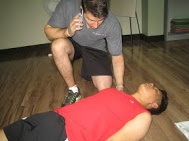Overview
When a person thinks of shock, they often think that this is what happens when the person is in distress or becomes surprised. However, really, shock is when the blood circulating throughout the body is not enough. In fact, it can be a life-threatening emergency. There are several causes of shock including severe burns, uncontrolled bleeding and injuries to the spine. A drop in blood pressure can cause the vital organs to not get enough blood to function. Therefore, when this happens, the person could die from lack of oxygen to their major organs.
Causes of Shock
- Heart condition (heart attack)
- External or internal loss of blood
- Dehydration or loss of fluids
- Serious allergic reaction
Shock Symptoms

There are several reasons why shock can occur, and these reasons are going to be one of the major reasons why symptoms may be different. However, here are some common shock symptoms:
- The person may have cold, clammy and pale skin
- Breathing may be slow and rapid
- Problem with breathing
- Rapid heartbeat
- Feeling anxious
- Dry mouth and severely thirsty
- Low amount of urine or dark urine
- Nausea
- Vomiting
- Dizziness
- Feeling light in the head
- Feeling confused or disorientated
- Being unconscious
Shock First Aid
Shock can be life threatening, thus, the first aid treatment that is given can actually save a person’s life. The first aid management techniques to keep in mind are:
- Follow the DRSABCD plan to assess the situation
- If the person is conscious, make sure you lie them down and allow them to get comfortable, such as loosening their clothing, helping to improve the blood flow by raising their legs above their head.
- Manage any signs of external bleeding, such as pressing bandages to a fresh wound, etc.
- Do not let the person eat or drink, even if they are very thirsty.
- Reassure the person and talk to them to ensure that they are patient while the ambulance arrives.
The Medical Outlook
For those who have shock, it can be life threatening, however, if the person gets proper medical care, they should make a complete recovery. However, there are issues that can arise such as:
- Person’s general health and age
- Type of and cause of shock
- Severity of the shock
- The time it takes to get medical attention
In cases in which the person has cardiogenic or septic shock, they have a higher chance of not making it. While other types of shock have a decent outlook.
Related Video On Medical Shock
https://www.youtube.com/watch?v=V4R9GSah93g
